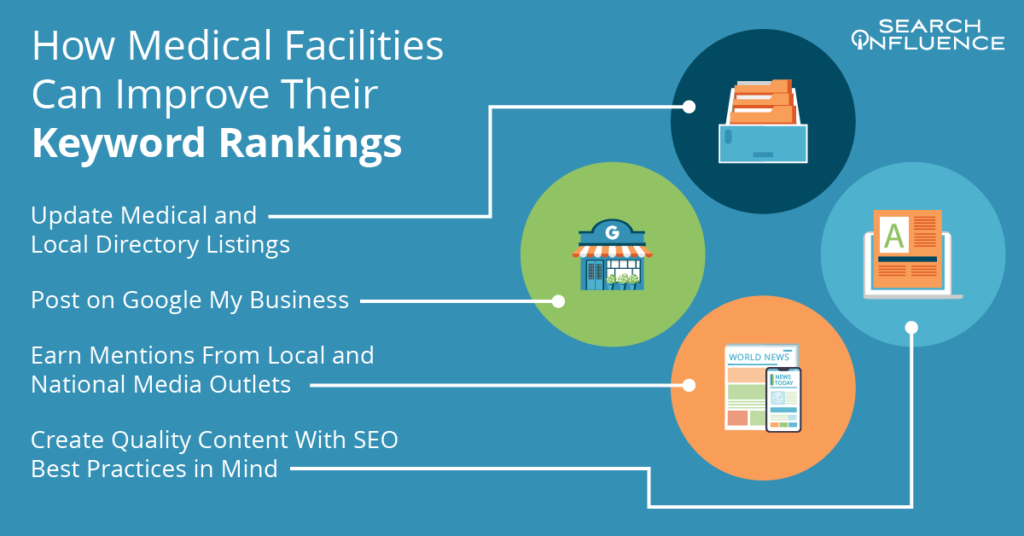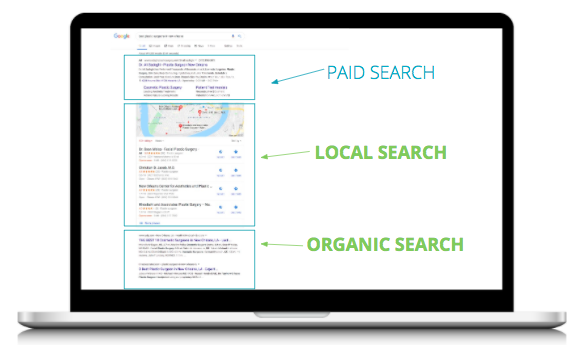How Hospitals and Healthcare Practices Can Adapt to Google Updates
October 9th, 2020 by
Key Insights
- Google decides what websites show as local and organic results by considering the business and it’s website’s relevance, prominence, and distance.
- Keywords, content, and connections continue to be required to earn trust with google and keep your website relevant. However, the WAY you think about keywords or the WAY you write content may need to adapt over time to Google’s changes.
- Google trusts up-to-date, accurate, and user-friendly content.
Google is continuously updating their algorithms. These changes are usually small, but now and then, a significant update affects the way marketers have to approach search engine optimizations. It’s crucial for marketers in the medical industry to promptly adjust to these updates because Google has additional regulations for healthcare websites.
The Basics of Google Search and SEO
Before diving into the algorithm updates, medical practices should understand a few optimization basics. Before a user searches for a keyword, Google has already analyzed and organized information from millions of webpages in its Search Index. When a search begins, Google’s algorithms sort through the index using hundreds of different factors to find relevant results. These results are then displayed in different formats so that people can find exactly what they’re searching for. Here is what the results most often look like:
This blog is all about making an impact in local and organic results, not paid search. Organic search refers to unpaid search results that appear because they are relevant. Local search refers to organic results for businesses or places that are in the same area as the searcher. These are often displayed as map results.
Google decides which websites to show as local and organic results by considering three factors:
- Relevance
- Authority
- Distance from the searcher
Relevance is how well a business profile matches a consumer’s search results. Authority is determined by a business’s presence online (links, articles, or directories) and offline (landmarks or locally known brick and mortar businesses). Distance from the searcher is, well, relatively straightforward.
Medical marketers must ensure that their practice’s online presence meets these three important Healthcare SEO ranking factors, which is where search engine optimization, or “SEO,” comes in.
There are three key components to having a successful SEO strategy:
- Keywords: What are people searching for? Which words or phrases do they use to find a new healthcare provider or information on a procedure?
- Content: Does the content on a website truly answer the question the searcher was asking?
- Connections: Does this website have backlinks or mentions from other, authoritative websites? Is there accurate information on the faculty, practice, or doctor listed on relevant directories like Google My Business or Healthgrades?
Despite periodic updates to Google’s algorithms and how they rank search results, these three components continue to be the basis of earning Google’s trust and keeping your website relevant. However, the way medical marketers think about keywords or write content has to adapt over time.
How Do Google Updates Impact Hospitals and Healthcare Practices?
Google is extra critical of health-related websites and has defined a specific content category for pages with content that could impact a person’s happiness, health, financial stability, or safety. These are called YMYL (Your Money, Your Life) pages and include hospitals and medical practices. The “Medic” update in August 2018 reflected the level of scrutiny Google uses when reviewing websites that deal with health or healthcare. Their goal is to discourage misleading information and ensure that searchers find trustworthy advice.
The credibility of the organization that runs the website impacts its rating, which is good news for large hospitals and other well known institutions. Hospitals are often considered a trusted source of information in their communities. On the other hand, smaller practices may have to work a little harder to prove their authority. But to rank well, it isn’t enough to be a trustworthy organization. The website must also have high-quality content.
How to Create Good Content
When writing content for a medical website, it’s vital to think about what Google considers good content and what information potential patients include in their searches. All content should be up to date, accurate, and user friendly. Marketers need to consider the following:
- Be Specific and Substantive: Websites should have detailed, in-depth information. Try to avoid lightly touching on a subject without providing any useful information. Searchers look for clear answers to their questions.
- Directly Answer Common Questions: Survey the medical staff to see the most common questions patients ask before, during, and after an appointment. Then, provide direct answers to these questions on the site.
- Use Subheadings: Use subheadings as a way to guide the reader down the page and direct a searcher to the section of the content that has the information they’re looking for.
- Use Bullet Points & Numbers: Break the information out into lists that are easier for readers to digest.
- Look at Top Ranking Pages: When in doubt, see what the top results for targeted keywords are doing and borrow some of their ideas. What type of information do they provide? How are their pages organized?
When considering what to write about, think of the keywords people are searching for and what information they expect to find. In the medical industry, there are typically two categories for searches: general health and healthcare. When someone searches a health term, they are looking for information about an ailment such as symptoms, causes, and treatments. Sites that rank for general health searches usually belong to large institutions, like the Mayo Clinic, which would be difficult to outrank.
It is important to have local content to leverage Google Maps and Google My Business. When someone searches for a doctor or specialty, like an orthopedic surgeon, they’re looking for healthcare and are considering going to a doctor. Healthcare searches are typically local because people tend to look for treatment in their area.
How to Rank in Local Search and on Google Maps
The earlier discussion about relevance, authority, and distance ties back in here. For Google Maps results, distance is the biggest factor. The physical location of the searcher determines the range of results they see. There’s no easy way to move closer to a searcher, so marketers have to focus on the factors they can control:
- Relevance:
- Have quality content for each specialty or procedure the practice offers
- Establish backlinks from trusted directories and other high ranking websites and local organizations
- Authority:
- Links pointing back to the practice’s site also improve authority
- Earn media mentions and directory listings
- Obtain and share as many quality reviews as possible with Google
Remember that the MOST important directory to update is Google, and information in Google My Business should always be up to date! With a verified hospital or medical practice category listing, marketers can set up specific hospital information (such as the different departments or doctors) to give patients a more direct search result.
If you’re ready to start improving your healthcare practice’s ranking for vital keywords in Google, Search Influence knows how to help. We help businesses grow online by developing SEO and digital marketing gameplans tailored for each of our clients. Request your marketing proposal and let’s make it happen today.
Images:




